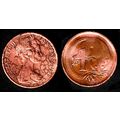Walsingham, Norfolk - Common Place, Moore Drug Store - local postcard c.1960s
- Condition : Used
- Dispatch : 2 Days
- Brand : None
- ID# : 143196662
- Quantity : 1 item
- Views : 288
- Location : United Kingdom

- Seller : justthebook (+1704)
- Barcode : None
- Start : Sat 26 Sep 2015 10:22:53 (BST)
- Close : Run Until Sold
- Remain : Run Until Sold
More Listings from This Seller view all
Seller's Description
- Postcard
- Picture / Image: The Common Place, Walsingham, Norfolk - shows a drug store called A. and J. D. Moore
- Publisher: The Walsingham Estate Co. / photo by Dave McClune (No. 4)
- Postally used: no
- Stamp: n/a
- Postmark(s): n/a
- Sent to: n/a
- Notes / condition:
Please ask if you need any other information and I will do the best I can to answer.
Image may be low res for illustrative purposes - if you need a higher definition image then please contact me and I may be able to send one. No cards have been trimmed (unless stated).
------------------------------------------------
Postage & Packing:
Postage and packing charge should be showing for your location (contact if not sure).
No additional charges for more than one postcard. You can buy as many postcards from me as you like and you will just pay the fee above once. Please wait for combined invoice. (If buying postcards with other things such as books, please contact or wait for invoice before paying).
Payment Methods:
UK - PayPal, Cheque (from UK bank) or postal order
Outside UK: PayPal ONLY (unless otherwise stated) please. NO non-UK currency checks or money orders (sorry).
NOTE: All postcards are sent in brand new stiffened envelopes which I have bought for the task. These are specially made to protect postcards and you may be able to re-use them. In addition there are other costs to sending so the above charge is not just for the stamp!
I will give a full refund if you are not fully satisfied with the postcard.
----------------------------------------------
Text from the free encyclopedia WIKIPEDIA may appear below to give a little background information (internal links may not work) :
*************
Walsingham is a village (actually two conjoined villages: Little Walsingham and Great Walsingham) in the English county of Norfolk. The village is famed for its religious shrines in honour of the Virgin Mary and as a major pilgrimage centre. It also contains the ruins of two medieval monastic houses.[1][2]
The civil parish, which includes the two Walsinghams, together with the depopulated medieval village of Egmere (grid reference TF 897 374), has an area of 18.98 km² and in the 2001 census had a population of 864 in 397 households. For the purposes of local government the parish falls within the district of North Norfolk.[3]
Walsingham became a major centre of pilgrimage. In 1061, according to the Walsingham legend, a Saxon noblewoman, Richeldis de Faverches, had a vision of the Virgin Mary in which she was instructed to build a replica of the house of the Holy Family in Nazareth in honour of the Annunciation. Her family name does not appear in the Domesday Book.
When it was built the Holy House, in Walsingham was panelled with wood and contained a wooden statue of an enthroned Virgin Mary with the child Jesus seated on her lap. Among its relics was a phial of the Virgin's milk.
Walsingham became one of northern Europe's great places of pilgrimage and remained so through most of the Middle Ages.
A priory of Canons Regular was established on the site in 1153, a few miles from the sea in the northern part of Norfolk and it grew in importance over the following centuries. Founded in the time of Edward the Confessor, the Chapel of Our Lady of Walsingham was confirmed to the Augustinian Canons a century later and enclosed within the priory. From the first, the shrine was a famous place of pilgrimage and the faithful came from all parts of England and the Continent until the destruction of the priory under King Henry VIII in 1538. To this day the main road of the pilgrims through Newmarket, Brandon and Fakenham is still called the Palmers' (Pilgrims') Way.
Many were the gifts of lands, rents and churches to the canons of Walsingham and many were the miracles sought and claimed at the shrine. Several English kings visited the shrine, including Henry III (1231 or 1241), Edward I (1289 and 1296), Edward II in 1315, Edward III in 1361, Henry VI in 1455, Henry VII in 1487 and finally Henry VIII, who was later responsible for its destruction when the shrine and abbey perished in the Dissolution of the Monasteries. Erasmus, in fulfilment of a vow, made a pilgrimage from Cambridge in 1511 and left as his offering a set of Greek verses expressive of his piety. Thirteen years later he wrote his colloquy on pilgrimages, wherein the wealth and magnificence of Walsingham are set forth and some of the reputed miracles rationalised. Two of Henry VIII's wives — Catherine of Aragon and Anne Boleyn — made pilgrimages to the shrine.
In 1537 while the last Prior, Richard Vowell, was paying obsequious respect to Thomas Cromwell, the Sub-Prior, Nicholas Milcham, was charged with conspiring to rebel against the suppression of the lesser monasteries and, on flimsy evidence, was convicted of high treason and hanged outside the Priory walls. Eleven people in all, including two lay choristers who had been instrumental in organising the revolt were hanged, drawn and quartered. What they feared would happen came the following year. In the July Prior Vowell assented to the destruction of Walsingham Priory and assisted the king's commissioners in the removal of the figure of Our Lady and many of the gold and silver ornaments and in the general spoliation of the shrine. For his ready compliance the Prior received a pension of 100 pounds a year, a large sum in those days, while 15 of the canons received pensions varying from four to six pounds. With the shrine dismantled and the priory destroyed, the site was sold by order of Henry VIII to Thomas Sidney for 90 pounds and a private mansion was subsequently erected on the spot. Gold and silver from the shrine was taken to London along with the statue of Mary and John (Jesus) which was later burnt.
The fall of the monastery gave rise to the anonymous Elizabethan ballad, The Walsingham Lament, on what the Norfolk people felt at the loss of their Shrine of Our Lady of Walsingham. The ballad includes the lines:
- Weep Weep O Walsingam,
- Whose dayes are nights,
- Blessings turned to blasphemies,
- Holy deeds to despites
- Whose dayes are nights,
- Sinne is where our Ladye sate,
- Heaven turned is to helle;
- Satan sitthe where our Lord did swaye,
- Walsingham O farewell!
- Heaven turned is to helle;
type=printed
city/ region=walsingham
period=post-war (1945 - present)
postage condition=unposted
number of items=single
size=continental/ modern (150x100mm)
Listing Information
| Listing Type | Gallery Listing |
| Listing ID# | 143196662 |
| Start Time | Sat 26 Sep 2015 10:22:53 (BST) |
| Close Time | Run Until Sold |
| Starting Bid | Fixed Price (no bidding) |
| Item Condition | Used |
| Bids | 0 |
| Views | 288 |
| Dispatch Time | 2 Days |
| Quantity | 1 |
| Location | United Kingdom |
| Auto Extend | No |



 for 1 item(s)
for 1 item(s)















